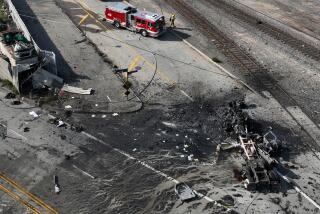Firefighters Fear Explosive Bumpers : Hazard: Some vehicles have a type of shock absorber that can burst during a blaze. An expert is unable to verify a single injury.
- Share via
Los Angeles firefighters say they have something to add to the list of potential disasters they face each time they approach a burning car: exploding bumpers.
But unlike the unseen threat of a burning battery producing a potentially lethal hydrogen vapor or that of melting seat cushions emitting a deadly cyanide-based gas, this hazard has firefighters reaching for their knees.
In response to new federal regulations, “safety bumpers” on many cars and trucks built beginning in the early 1980s contain a small gas or gel-filled shock absorber designed to minimize damage to vehicles in low-speed collisions.
But when these pressurized cylinders get too hot, such as during an engine compartment fire, they sometimes burst.
“It becomes a projectile--like a rocket,” said George DeMott, a Los Angeles City Fire Department captain and 27-year veteran.
Though there are no statistics on the hazard, tales of exploding bumpers are regularly swapped among Los Angeles firefighters.
A North Hollywood captain said he’s heard of one device blasting through a wooden garage door, and another flying more than 100 feet from a flaming car. And in March witnesses looked on as one of the projectiles was launched more than 30 feet from the front bumper of a burning car on the Golden State Freeway.
While other auto makers began phasing out the pressurized mechanisms when federal bumper standards were relaxed to 2.5 m.p.h. in 1983, Ford continues to use the device in its Taurus, Crown Victoria and Tempo model cars.
Ford spokesman Mike Parris said that although they are more expensive to produce, the company continues to use this type of bumper because it meets the tougher 5 m.p.h. standards, something he said is difficult to accomplish with the newer plastic designs.
“You’ve got to look out for the consumer at some point,” he said. “And these save on the repair bills.”
Parris said the company has received no reports of bumper mechanisms bursting on its cars or trucks.
Another danger is that after being compressed in a collision, bumpers can release without warning, thrusting forward not only with pressure contained in the shock absorber, but also with the energy absorbed in the collision.
“If someone is standing in front of one of those, it’ll break their legs,” said Thomas Frank, also a captain with the Los Angeles City Fire Department. So seriously is the threat taken by the department that in 1987 a supplement was added to its training manual on how to avoid front and rear bumpers while fighting a car fire.
The rarity of the hazard was confirmed by John Ottoson, a senior analyst with the United States Fire Administration.
“One of our functions is tracking down the hazards firefighters face,” said Ottoson. “And I haven’t seen this very frequently.”
He said the bumpers, which “burst, not explode,” received a lot of attention in the fire service trade press last year, but he was unable to verify a single account of an injury caused by a bumper. But the irony of “safety bumpers,” DeMott said, is that they are designed to save property, not lives, but simultaneously put firefighters at risk.
“It’s strictly the money value. It’s saving the insurance companies on damage to vehicles,” he said. “I’d rather see that money get spent than see even one fireman get hurt.”
But Fran Seeger, of the Insurance Institute for Highway Safety, a research and communications firm funded by insurance companies, said damage resulting from low-speed collisions is costing more now than ever.
“Bumpers perform more poorly now than when there was a 5 m.p.h. standard because design factors are overtaking absorbency factors,” Seeger said.
The institute this week released a report showing that eight of nine four-door midsized sedans sustained more damage in crash tests in 1993 than was sustained in the same test in 1991.
“We’re sliding back down that slippery slope,” said Brian O’Neill, institute president.
But General Motors spokesman Jack Dinan defended his company’s standards.
“Not only do we meet the law,” he said, “most of our cars exceed it.”
More to Read
Sign up for Essential California
The most important California stories and recommendations in your inbox every morning.
You may occasionally receive promotional content from the Los Angeles Times.














